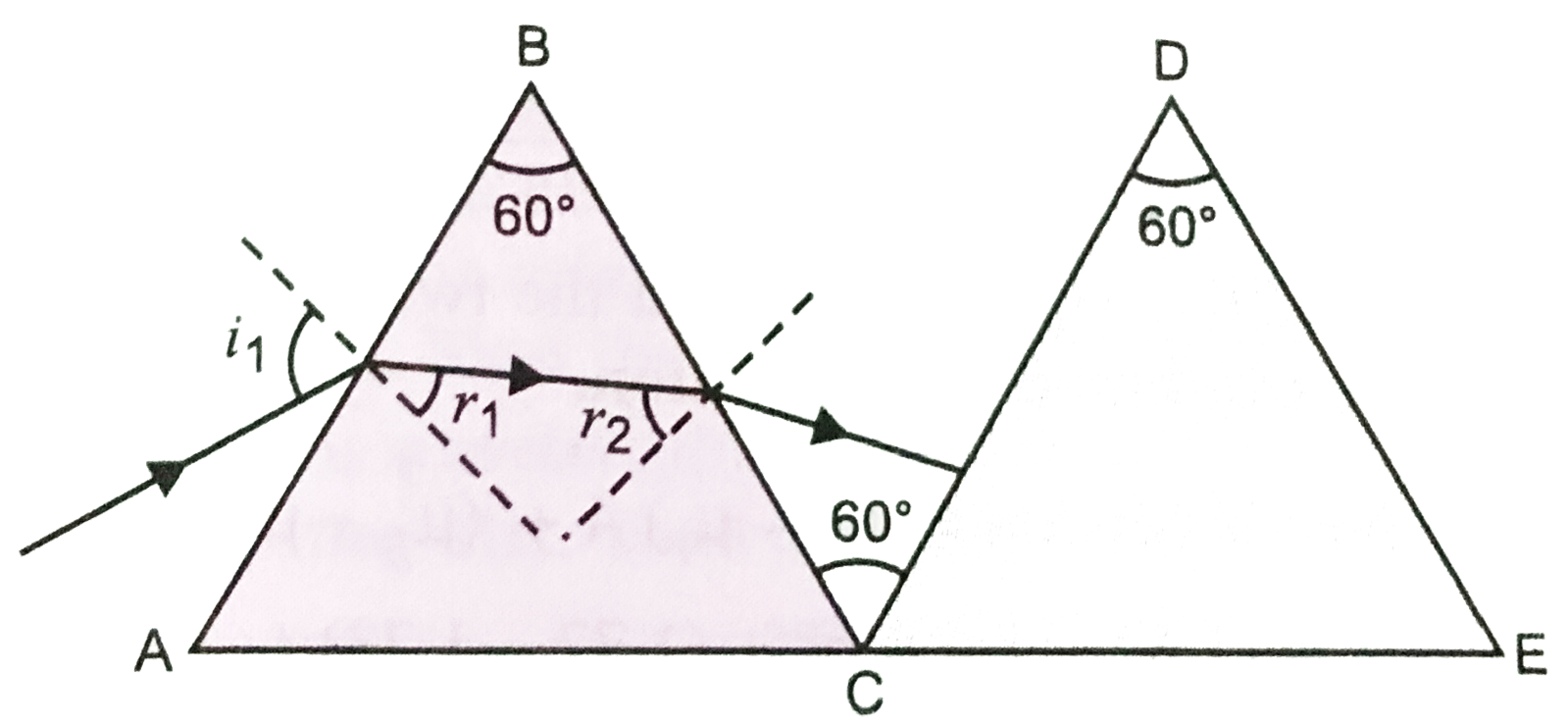Assertion : Any ray of light suffers a deviation of (180∘−2i) after one reflection.
Reason : For normal incidence of light deviation is zero.
(a) If both Assertion and Reason are true and the Reason is correct explanation of the Assertion.
(b) If both Assertion and Reason are true but Reason is not the correct explanation of Assertion.
(c) If Assertion is true, but the Reason is false.
(d) If Assertion is false but the Reason is true.
The correct Answer is:C
To solve the question, we need to analyze both the assertion and the reason provided.
1. Understanding the Assertion:
The assertion states that any ray of light suffers a deviation of (180∘−2i) after one reflection.
- When a ray of light strikes a reflective surface, it reflects off at an angle equal to the angle of incidence (according to the law of reflection: angle of incidence i = angle of reflection r).
- The total deviation D can be calculated as the difference between the initial direction of the ray and its final direction after reflection.
2. Calculating Deviation:
- The initial direction of the ray can be considered as a straight line (0 degrees).
- After reflection, the ray deviates by an angle 2i (since it goes from i to r).
- Therefore, the total deviation D is given by:
D=180∘−2i
- This confirms that the assertion is true.
3. Understanding the Reason:
The reason states that for normal incidence of light, the deviation is zero.
- Normal incidence occurs when the angle of incidence i=0∘.
- Substituting i=0∘ into the deviation formula:
D=180∘−2(0∘)=180∘
- This indicates that the deviation is not zero; instead, it is 180∘. Thus, the reason is false.
4. Conclusion:
- The assertion is true, while the reason is false. Therefore, the correct conclusion is that the assertion is correct, but the reason provided does not support it.
Final Answer:
- Assertion: True
- Reason: False
The assertion states that any ray of light suffers a deviation of (180∘−2i) after one reflection.
- When a ray of light strikes a reflective surface, it reflects off at an angle equal to the angle of incidence (according to the law of reflection: angle of incidence i = angle of reflection r).
- The total deviation D can be calculated as the difference between the initial direction of the ray and its final direction after reflection.
- The initial direction of the ray can be considered as a straight line (0 degrees).
- After reflection, the ray deviates by an angle 2i (since it goes from i to r).
- Therefore, the total deviation D is given by:
D=180∘−2i
- This confirms that the assertion is true.
The reason states that for normal incidence of light, the deviation is zero.
- Normal incidence occurs when the angle of incidence i=0∘.
- Substituting i=0∘ into the deviation formula:
D=180∘−2(0∘)=180∘
- This indicates that the deviation is not zero; instead, it is 180∘. Thus, the reason is false.
- The assertion is true, while the reason is false. Therefore, the correct conclusion is that the assertion is correct, but the reason provided does not support it.
- Assertion: True
- Reason: False
Topper's Solved these Questions
- BOOK - DC PANDEY ENGLISHCHAPTER - REFLECTION OF LIGHTEXERCISE - Exercise Level 1 Objective12videos
REFLECTION OF LIGHT
- BOOK - DC PANDEY ENGLISHCHAPTER - REFLECTION OF LIGHTEXERCISE - Exercise Level 1 Subjective17videos
REFLECTION OF LIGHT
- BOOK - DC PANDEY ENGLISHCHAPTER - REFLECTION OF LIGHTEXERCISE - Introductory Exercise1videos
REFLECTION OF LIGHT
- BOOK - DC PANDEY ENGLISHCHAPTER - RAY OPTICSEXERCISE - Medical entrance gallary76videos
RAY OPTICS
- BOOK - DC PANDEY ENGLISHCHAPTER - REFRACTION OF LIGHTEXERCISE - Level 2 Subjective21videos
REFRACTION OF LIGHT
Similar Questions
Assertion : Two plane mirrors kept at right angles deviate any ray of light by 180∘ after two reflection.
Reason : The above condition is satisfied only for angle of incidence i=45∘.View SolutionA ray of light suffers a minimum deviation when incident on equilateral prism of refractive index √2 The angle of deviation is
View Solution
Knowledge Check
- Question 1 - Select One
A ray of light suffers refraction through an equilateral prism. The deviation produced by the prism does not depend on the:
Aangle of incidenceBcolour of lightCmaterial of prismDsize of prism
Assertion : In reflection from a denser medium, any ray of light suffers a phase difference of π.
Reason : Denser medium is that medium in which speed of wave is less.View SolutionA ray of light is incident on a prism ABC of μ=√3 as shown in Fig. Find the angle of incidence for which the deviation of light by the prism ABC is minimum.
By what angle should the second prism be rotated so that final ray suffers net minimum deviation ?
 View Solution
View SolutionAssertion: Ray of light passing through optical centre of a lens goes undeviated.
Reason: Ray falls normal at optical centre and in normal incidence, there is no deviation of light.View SolutionA ray of light in air is incident on a glass plate at polarising angle of incidence. It suffers a deviations of 22∘ on entering glass. The angle of polarisation is
View SolutionAn isosceles prism has one of the refracting surfaces silvered. A ray of light is incident normally on the refracting face AB. After two reflections, the ray emerges from the base of the prism perpendicular to it. Find the angle of the prism.
View SolutionTwo plane mirrror are inclined to each other at 70∘. A ray of light is incident on one mirror. They ray after two reflections will undergo a total deviation of :
View SolutionA ray passes through a prism of angle 60∘ in minimum deviation position and suffers a deviation of 30∘. What is the angle of incidence on the prism
View Solution

